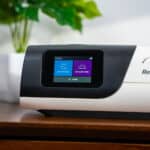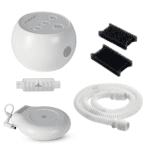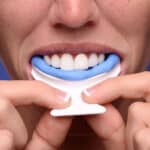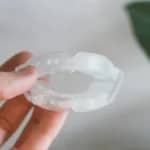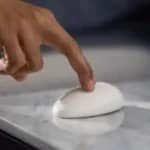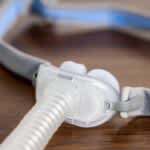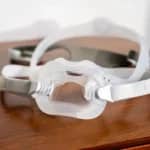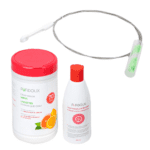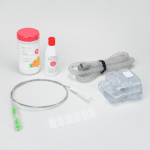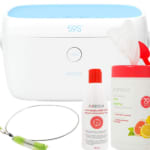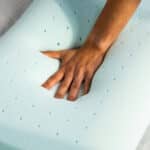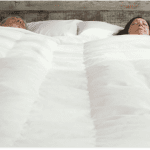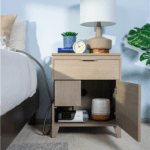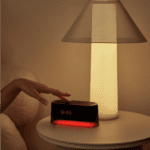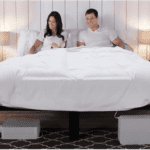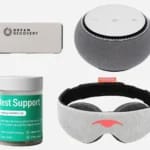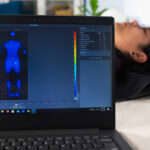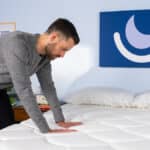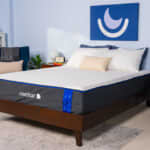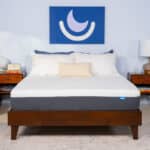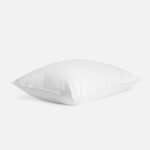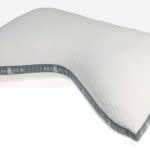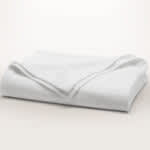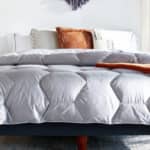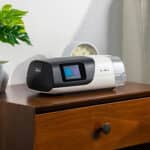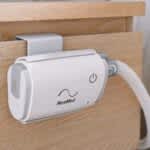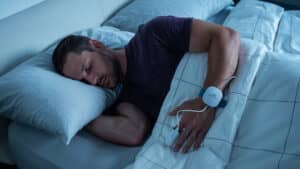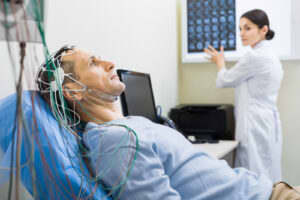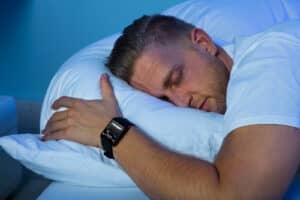In the United States, roughly 24 million people live with the symptoms of sleep apnea without realizing that they have it. For many of them, at-home sleep apnea testing could be one way to get their condition diagnosed and begin receiving treatment to improve it.
Obstructive sleep apnea (OSA) is a sleep disorder that causes a person to stop breathing for brief periods because of a partial or total blockage of the upper airway. People with OSA experience frequent sleep interruptions and snoring and may also choke or gasp as they sleep.
Untreated OSA can cause poor-quality sleep and daytime sleepiness, but it also increases the risk of many serious illnesses. This is why any doctor who suspects a person has OSA will recommend sleep apnea testing, either in a sleep lab or at home.
Learning the basics of home sleep apnea tests can help you decide whether to talk to your doctor about taking one.
Key Takeaways
- At-home sleep apnea tests offer a convenient and accessible way to assess sleep apnea from home.
- At-home tests involve wearing a small device that monitors sleep patterns.
- Benefits include the comfort of testing at home, cost-effectiveness, and time efficiency.
- Home tests may have limitations or unclear results and a follow-up study in a clinic may be required.
What Is an At-Home Sleep Apnea Test?
An at-home sleep apnea test is a method of diagnosing obstructive sleep apnea in a person’s home, rather than in a sleep laboratory. This test uses a portable device to measure breathing and other health signs while a person sleeps.
At-home sleep apnea tests are different from sleep disorder testing called polysomnography (PSG). A PSG takes place in a sleep laboratory or sleep clinic, and a technician stays in the lab to monitor the person as they sleep.
While a PSG is considered the most accurate means of diagnosing obstructive sleep apnea, at-home testing may be a good alternative for certain people. These include people whose symptoms suggest that they have moderate or severe OSA and who don’t have other medical conditions that can affect their breathing while they sleep.
Doctors do not typically recommend at-home sleep apnea testing for people who may have other sleep disorders, such as narcolepsy or insomnia, or for people whose jobs require them to be alert as a matter of public safety.
How Do At-Home Sleep Apnea Tests Work?
At-home sleep apnea tests use sensors attached to a person’s body to measure certain variables while they sleep. These measurements can provide doctors with the information needed to diagnose obstructive sleep apnea.
The number of sensors and types of measurements depends on the specific test device. The device may collect measurements using a wrist band, finger clip, chest strap, nasal cannula, and/or sensors placed on the chest or neck. These instruments may record a sleeper’s:
- Breathing effort
- Snoring
- Airflow
- Blood oxygen level
- Heart rate
- Body position
- Peripheral arterial tone (PAT)
Some at-home tests, called type 3 devices, measure as many as seven variables. Others, called type 4 devices, measure only up to three variables.
Your doctor can help guide you through setting up the equipment and attaching the monitoring devices correctly. Most of the time, you will only need to sleep using the testing equipment for one night in order to collect enough data for your doctor to interpret.
An At-Home Sleep Test May Be the Answer

Save 54% on your Sleep Test Today
SHOP NOWSimple and convenient
- Equipment delivered to your doorstep
- One overnight test in the comfort of your own bed
Uncover sleep apnea
- Quietly collects data while you sleep
- 98% effective in detecting sleep apnea
Affordable & ships fast
- In-lab sleep tests cost ~$3,000+ (this one’s $189), HSA/FSA eligible
- Arrives in 2-4 business days
Is an At-Home Sleep Apnea Test Right for You?
If your doctor suspects that you have moderate or severe obstructive sleep apnea, and if you don’t have any characteristics that could interfere with the at-home test results, you might be a good candidate for an at-home sleep apnea test.
At-home sleep apnea testing may be an attractive option if you are unable to make an appointment at a sleep clinic or if the only appointments available are too far in the future. You may also simply prefer to stay in the comfort of your home, where you are accustomed to sleeping normally.

In general, doctors will not recommend home sleep apnea testing if they think you could have another sleep disorder or complicated OSA, meaning other health conditions could worsen your breathing when combined with OSA. Heart failure, chronic obstructive pulmonary disorder (COPD), regular opioid use, and a history of stroke can all contribute to complicated OSA.
Also, if your job could endanger yourself or other people if you can’t stay alert, your doctor will likely recommend a more sensitive sleep study in a lab. If you are a taxi or bus driver, police officer, airline pilot, or another “mission-critical” worker, becoming drowsy because of a missed OSA diagnosis could put lives at risk.
It’s worth keeping in mind that taking an at-home test does not guarantee that you’ll avoid polysomnography. If an at-home test has negative results but your doctor still thinks you could have OSA, they may recommend that you have follow-up testing in a sleep lab.
Benefits of Doing an At-Home Sleep Apnea Test
At-home sleep apnea tests can offer several benefits. These tests can be:
- Performed in the comfort of your home
- Convenient and easily accessible
- More affordable
- Arranged around your schedule
- Less time-consuming
- Discreet
Having the option of taking the test at home also removes barriers for people who are reluctant to spend time in a sleep lab. This could lead to OSA being effectively controlled in people who otherwise would not be diagnosed at all.
What to Consider Before Taking an At-Home Sleep Apnea Test
Besides the potential benefits, there are several possible drawbacks to taking a sleep apnea test at home.
- Less Accurate: Although at-home tests continue to improve, they are still considered less accurate than an in-lab sleep study. At-home sleep apnea tests are more likely to miss a sleep apnea diagnosis.
- No Overnight Support: At-home sleep apnea tests are not attended by trained sleep professionals who can give advice or help with adjusting or repositioning the equipment.
- Incomplete Data: At-home tests cannot collect as much information as in-lab polysomnography. For instance, they do not record a sleeper’s brain waves. This limitation means that at-home tests may give an incomplete picture of a person’s sleep and can’t help to diagnose other sleep disorders a person may have.
Understanding Your Results
Anyone who takes a sleep apnea test at home should go over their test results with their doctor. Home test devices provide raw data for your sleep doctor to analyze, but they do not diagnose OSA on their own.
When your doctor discusses your results with you, they may bring attention to your apnea-hypopnea index (AHI). The AHI represents your average number of breathing disruptions for each hour you have slept during the test. Doctors use AHI in diagnosing OSA and to determine how severe the condition is.
If your at-home sleep apnea test result is negative or inconclusive, but your doctor still suspects obstructive sleep apnea, they may order a sleep apnea test performed in a sleep lab. Some health insurance providers require a second negative at-home sleep apnea test before covering for polysomnography at a sleep lab.
Preparing for an At-Home Sleep Apnea Test
On the day that you take an at-home sleep apnea test, it’s important to set yourself up for a good night’s sleep so that the test will successfully collect enough data. This can involve paying attention to several features of your daily routine.
- Medications: Unless your doctor has advised you otherwise, continue taking any medications you usually take.
- Alcohol: Unless your doctor has advised you otherwise, avoid drinking alcohol the day of the sleep apnea test.
- Caffeine: Stay away from caffeinated drinks such as tea, soda, and coffee during the afternoon and evening hours.
- Hair and Body Products: Hair gel, body lotion, face makeup, and similar products might make it harder for test sensors to stay in place.
- Napping: Try not to nap on the day of the test.
The Best Home Sleep Apnea Test
There are various home sleep apnea tests that you or your doctor may select to evaluate you for OSA, with each using different equipment and processes. The Sleep Doctor Home Sleep Test is among the most advanced options available, and is an excellent choice for people over the age of 18.
The Sleep Doctor HST measures a number of variables using only a device worn like a wristwatch, a finger clip, and a chest sensor. These variables include your heart rate, blood oxygen level, snoring, and chest motion. While you sleep, the Sleep Doctor HST records this data. Then it transmits the data to a sleep doctor using your cell phone’s Bluetooth signal.
The process for obtaining and taking the Sleep Doctor test is simple. First, you order the test online. Then you have an arranged video chat with a sleep specialist, after which you select a night to take the test. Following the test, your results will be available to you and to a sleep specialist, who will make a diagnosis if appropriate.
Sleep Doctor offers customer support as well as sleep coaching for people diagnosed with sleep apnea after using the test. Customers have offered praise for the Sleep Doctor HST’s comfort and price, as well as for how easy they’ve found it to use.
References
The Sleep Doctor Forum: Real Experiences, Real Connections
Continue the discussion on the Sleep Doctor Forum. Connect with experts and fellow forum members on CPAP, sleep apnea, and all things sleep. A priceless resource that’s free to join.

